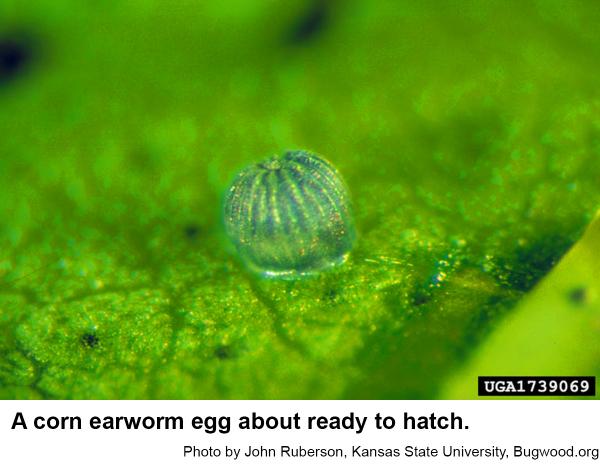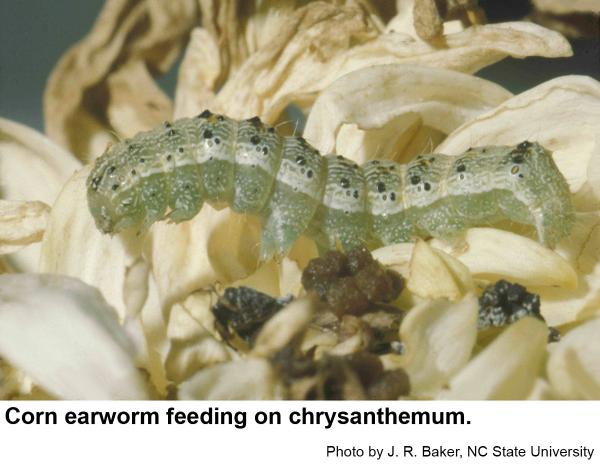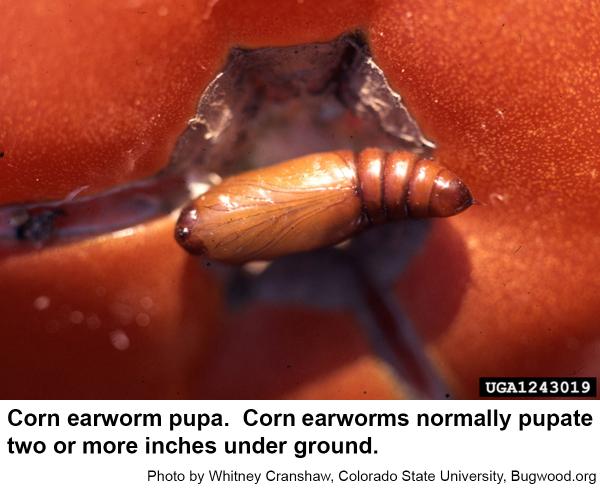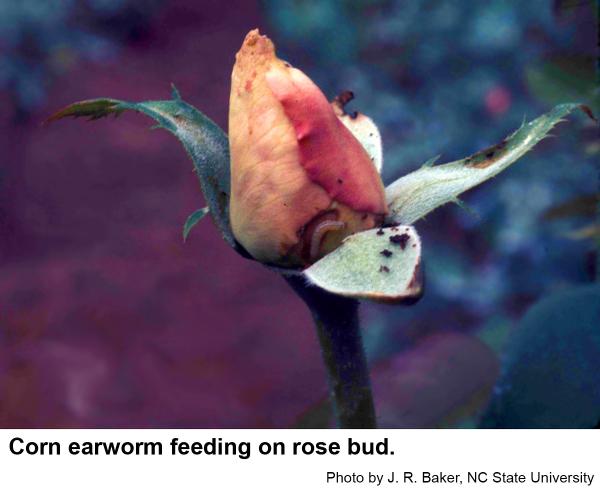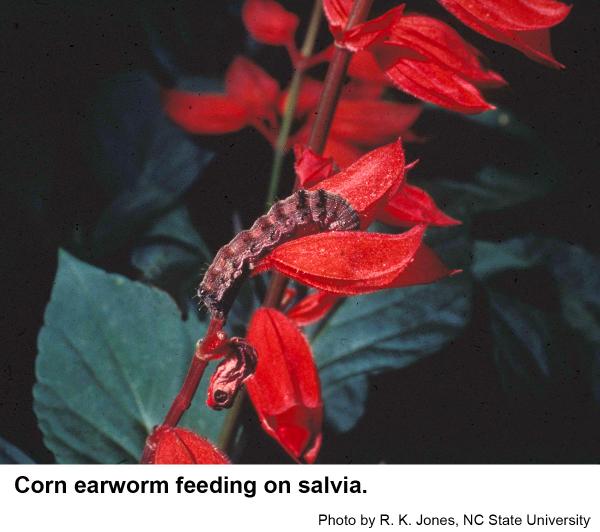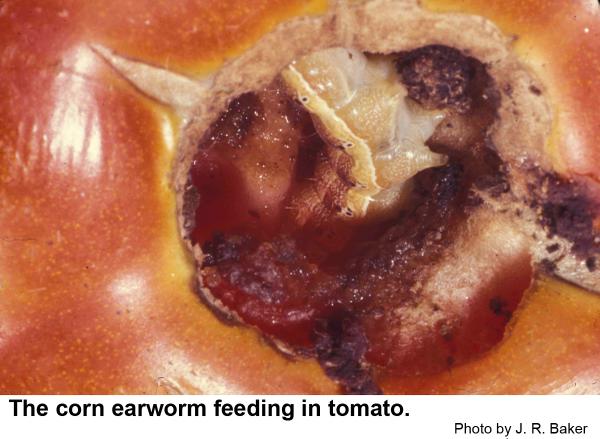Description and Biology
As the field crops dry out, corn earworm moths, Helicoverpa zea, lay their eggs on just about anything that is green. It is also known as the tomato fruitworm, the sorghum headworm, the vetchworm, and cotton bollworm. The corn earworm is the second most damaging pest in the United States and is sometimes highly damaging to ornamental crops, especially in middle to late summer when field crops and weeds are drying up, and the only succulent plants left are ornamentals. Corn earworm moths are medium sized and tan to yellowish-brown with darker spots. Forewings of males are usually light yellowish-olive; those of the female are yellowish-brown to pinkish-brown. Each forewing has a dark spot near the center. The moths are active at night, but sometimes fly during the day as well. Females do not lay eggs in masses, but seem to fly from plant to plant laying an egg or two on each. Females can lay 400 to 3,000 whitish-yellow eggs each. Eggs darken and hatch in a few days, and the tiny caterpillars feed on buds, flowers, leaves and fruit. Caterpillars eventually grow to 1 ¾ inches long. When fully grown, this moderately hairy larva is pale-striped, black-spotted and predominantly yellowish-green, brown or reddish-brown with a tan to orange head. When disturbed, it curls up tightly, remaining motionless for a few seconds. Development takes two to three weeks at which time the caterpillars burrow into the soil to pupate. We have at least four generations per year, and corn earworms become most abundant in late summer. The last generation overwinters as pupae more than two inches under ground.
Host Plants
The corn earworm infests over 100 plants, but corn is the preferred host. In the South it occurs on at least 17 cultivated plants: alfalfa, bean, carnation, chrysanthemum, corn, cotton, geranium, gladiolus, nasturtium, okra, peanut, pea, rose, salvia, snapdragon, sorghum, soybean, strawberry, sunflower, sweet pepper, sweet potato, tobacco, tomato and zinnia. The earworm is also found on wild hosts such as toadflax, deergrass, common mallow, crown vetch, fall panicum, hemp, horsenettle, lambsquarters, lupine, morningglory, pigweed, prickly sida, purslane, ragweed, and velvetleaf,
Residential Recommendations
In hobby greenhouses, damage by corn earworms in a greenhouse can be reduced by adequate screening of window and open areas, as well as proper sealing of door edges. Releasing natural enemies (e.g., Trichogramma wasps and predatory insects) in a residential greenhouse may help control corn earworm if vents cannot be screened. Because the corn earworm feeds on hundreds of kinds of plants, it has not developed resistance to most of the insecticides labeled for home landscape use found in big box stores and garden centers. However, corn earworms have developed resistance to the Bacillus thuringiensis Cry1Ab toxin that has been genetically engineered into some field corn cultivars.
References
- Common name: corn earworm, scientific name: Helicoverpa (=Heliothis) zea (Boddie) (Insecta: Lepidoptera: Noctuidae). Capinera, J. L. 2007 (revised). Featured Creatures, Entomology & Nematology, FDACS/DPI, EDIS Publication Number: EENY-145.
- Insect and Related Pests of Flowers and Foliage Plants. Baker, J. R. ed. 1994 (revised). NC Cooperative Extension Service pub. AG-136.
- Insect and related pests of vegetables. Sorensen, K. A. and J. R. Baker eds. 1994. North Carolina Agricultural Extension Service publication AG-295. 180 pp.
- The biology of the tobacco budworm and the corn earworm in North Carolina with particular reference to tobacco as a host. Neunzig, H. H. 1969. North Carolina Agricultural Experiment Station Technical Bulletin 196. 76 pp.
- The eggs and early-instar larvae of Heliothis zea and Heliothis virescens (Lepidoptera: Noctuidae). Neunzig, H. H. 1964. Annals of the Entomological Society of America 57: 98-102.
- Wild host plants of the corn earworm and the tobacco budworm in eastern North Carolina. Neunzig, H. H. 1963. Journal of Economic Entomology 56: 135-139.
- Extension Plant Pathology Publications and Factsheets
- Horticultural Science Publications
- North Carolina Agricultural Chemicals Manual
For assistance with a specific problem, contact your local Cooperative Extension Center.
This Factsheet has not been peer reviewed.
Publication date: May 30, 2016
Reviewed/Revised: Sept. 12, 2019
Recommendations for the use of agricultural chemicals are included in this publication as a convenience to the reader. The use of brand names and any mention or listing of commercial products or services in this publication does not imply endorsement by NC State University or N.C. A&T State University nor discrimination against similar products or services not mentioned. Individuals who use agricultural chemicals are responsible for ensuring that the intended use complies with current regulations and conforms to the product label. Be sure to obtain current information about usage regulations and examine a current product label before applying any chemical. For assistance, contact your local N.C. Cooperative Extension county center.
N.C. Cooperative Extension prohibits discrimination and harassment regardless of age, color, disability, family and marital status, gender identity, national origin, political beliefs, race, religion, sex (including pregnancy), sexual orientation and veteran status.


